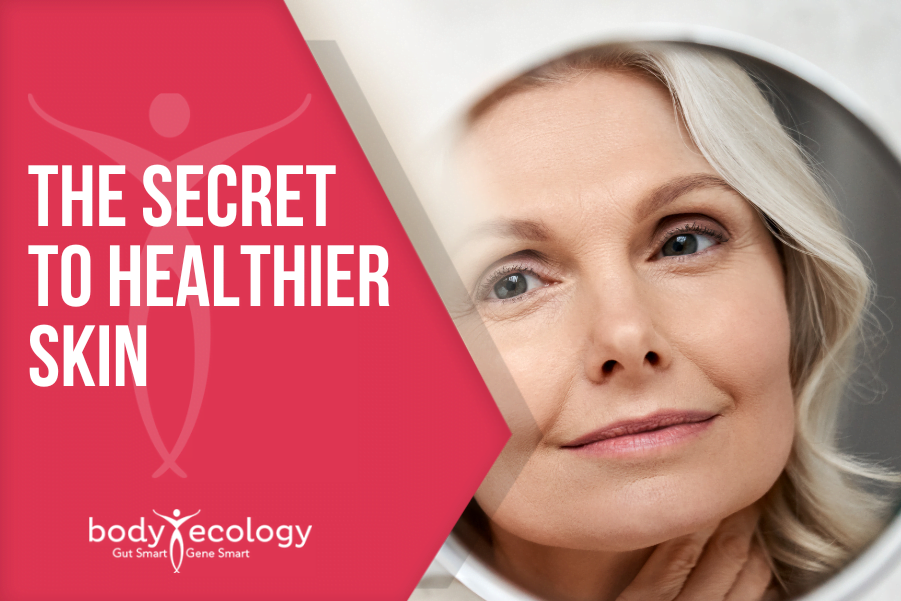Healthier, Younger Looking Skin from A Surprising Source

You may have heard the phrase “healthy skin from the inside out” and wondered: What healthy habits can I adopt that will make my skin look younger, more radiant, and healthy?
Remember that your skin is generally a reflection of what’s going on inside your body, especially your digestive tract. You may be following a strict skincare routine, but that’s really secondary to what’s happening under the surface.
The most expensive topical products in the world can’t hide the look of dry, lifeless, aging skin.
 One of the basic tips for beautiful skin is to stay hydrated by drinking plenty of clean, purified water, but adding minerals to the water is even smarter. Ancient Earth Minerals provide protection from free radicals which are a major contributor to skin aging. Drinking water helps to flush toxins out of your body, which can also collect in your skin cells, but the humic and fulvic minerals in Ancient Earth Minerals are well-known for their ability to enhance our body’s ability to detoxify.
One of the basic tips for beautiful skin is to stay hydrated by drinking plenty of clean, purified water, but adding minerals to the water is even smarter. Ancient Earth Minerals provide protection from free radicals which are a major contributor to skin aging. Drinking water helps to flush toxins out of your body, which can also collect in your skin cells, but the humic and fulvic minerals in Ancient Earth Minerals are well-known for their ability to enhance our body’s ability to detoxify.
Humic and fulvic minerals:
– provide cell protection from free radicals
– replenish electrolytes
– detoxify and remove harmful compounds from the skin,
– can transport up to 60 times its own weight in nutrients directly to the cells
– boost cellular energy.
Organic components in the skin, like hyaluronic acid and collagen, function best in a hydrophilic environment. These building blocks and others help to give your skin its plumpness and elasticity.
Your skin has its own topical microbiome that is unique to you. Your skin’s appearance can be a giveaway if its microbiome is out of balance. If you’re battling redness, dryness, acne, or wrinkles, your skin microbiome could be crying out for some attention.
As with most things, balance is key. For example, your skin can be too clean. If you’re struggling with skin issues, like chronic dryness, outbreaks, or flare-ups of a condition like eczema, you might be overdoing it with a cleanser that’s too harsh for your skin. The soaps, shampoos etc that most people use on their skin to keep it clean are stripping off the microbiome.
The beauty industry markets complexion brushes, soaps, exfoliating agents, astringents, and other topical treatments to cleanse the skin, but just how “clean” is skin supposed to be? Achieving “clean” skin may not be the best goal.
Ending your day by scrubbing your skin with a harsh facial cleanser and/or antibacterial soap disrupts the skin microbiome — with unpleasant consequences.
Here’s Exactly What Your Skin Microbiome Does
It can take a toll on your mental and emotional wellbeing to continually struggle with your appearance. Luckily, feeling and looking good in your skin is a lot simpler than many cosmetic manufacturers, beauty bloggers, and influencers make it out to be. Determining what your skin really needs could be the defining factor in keeping your complexion youthful and fresh.
The microorganisms found on your skin have a number of potentially beneficial effects (and some potentially negative effects) for skin health and beyond.
For example:
– Some beneficial bacteria help strengthen the skin as a natural barrier against harmful organisms.
– They also help maintain skin pH and produce a variety of useful compounds and enzymes that help nourish the skin and guard against the damaging effects of ultraviolet light, other sources of oxidative damage, and inflammation.
– The skin microbiome may even have a role in helping to resist skin cancer.
In contrast, pathogenic microorganisms may alter skin pH, disturb the skin barrier, and upset skin moisture levels, contributing to dry, cracked, inflamed, and infected skin — as well as acne, rosacea, and other skin issues.
There’s a natural tendency to scrub off pathogens with antibacterial soap or a harsh facial cleanser with unpleasant consequences. Healthy skin is anything but “clean” — instead, it’s teeming with beneficial microorganisms that the skin relies on to stay happy and balanced. Stripping the skin of beneficial bacteria allows pathogens to dominate, leading to angry, inflamed skin outbreaks, dry skin, rosacea, and psoriasis.
There’s A Better Way: The Gut Skin Axis
Researchers have been exploring the link between gut dysbiosis and the skin in numerous research studies for several years now. It’s now well known that gut dysbiosis causes skin dysbiosis and promotes the development of inflammatory skin disorders.
For example, rosacea—an embarrassing condition that many women try to hide by wearing toxic makeup—is an inflammatory skin disorder. So is acne, psoriasis, dandruff, atopic dermatitis and even skin cancer. There is an increased risk of gastrointestinal disorders in rosacea patients. SIBO (a small intestine bacterial overgrowth) has been found to be associated with rosacea. When the SIBO is eliminated there is a significant reduction in lesions.
Helicobacter pylori infection (HPI) has also been associated with rosacea. An H. pylori infection is well known for its role in causing peptic ulcers and is a risk factor for stomach cancer. In one study, 84% of the 31 patients who had rosacea tested positive for H.pylori. Dermatologists seem to be unaware of this connection.
Lactobacillus Plantarum Increases Skin Hydration
The advancement in genetic testing in the past few years has allowed researchers to have a better understanding of the microbes inhabiting our gut. Firmicutes, Bacteroidetes, Actinobacteria and Proteobacteria are the main bacterial communities in the gastrointestinal tract. Lactobacillus belongs to the firmicutes phylum. It makes lactate, acetate (a health-promoting short chain fatty acid) and produces antimicrobial substances that fight pathogens in your gut.
Lactobacillus plantarum bacteria has been found to have positive anti-aging benefits on the skin. In one 12 week study with 110 volunteers (between 41 and 59 years old) who had dry skin and wrinkles researchers found that Lactobacillus plantarum improved skin hydration and had anti-photoaging effects. Skin elasticity and skin gloss were also measured. The participants were divided into a probiotic group and a control group.
By the 12th week there was a significant increase in the water content in the face, forearm and hands of the volunteers who were consuming the Lactobacillus—meaning the skin on the face and hands were more hydrated. The researchers observed a significant decrease in water loss in the face and forearm but especially in the face. There was also a significant reduction in wrinkle depth and a significant improvement in skin gloss by the 12th week. Skin elasticity improved by 13.17% after only 4 weeks but by 21.73% after 12 weeks.
RNA-seq analysis showed Lactobacillus plantarum’s ability to restore the integrity of the gut barrier by regulating gene expression associated with immunity—which is related to skin and intestinal permeability. The results of the 12 week study demonstrate the role of Lactobacillus plantarum on skin health by balancing the condition of the gut.
Nutricosmetics Nourish Your Body From The Inside, Out
Have you heard this term before? A nutricosmetic is a product or ingredient that acts as a nutritional supplement—working from the inside to promote beauty of the skin, hair and nails. Nutricosmetics are the latest trend in the beauty industry. Basically, as the study shows, Lactobacillus plantarum is a nutricosmetic.
You will find ample amounts of Lactobacillus plantarum in a Body Ecology meal if you add a couple of tablespoons of the cultured vegetables to your plate. If you make your own fermented vegetables using our Body Ecology Veggie Culture Starter the numbers will be even higher…much higher. Lactobacillus Plantarum and many other species of Lactobacillus are also abundant in our Probiotic Liquids.
Another nutricosmetic is spirulina protein, like that found in Body Ecology’s Super Spirulina Plus powder. In addition to having powerful antioxidant and anti-inflammatory properties, research suggests that this ancient superfood from the sea may also promote skin wound repair.
Because the skin protects the body from environmental damage and microbial infection, ingredients that support wound repair are critical for healthy skin function.
As research continues into the complex role microorganisms play in the health of the skin, beauty brands and even dermatologists will become more educated in ways we can support this bionetwork — both aesthetically and internally, or from the inside out.










